








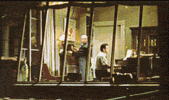
Perhaps
one of the most surrealistic elements that consistently appears in Hitchcock’s
films is Hitchcock himself. Beginning with The Lodger in
1926, Hitchcock has made a habit of making cameo appearances in each of
his films. These scenes often serve some symbolic purpose and establish
Hitchcock’s role in the film. His cameo in Shadow of a Doubt
shows Hitchcock holding all the Spades in a game of Poker, clearly establishing
his power as the controller of everything in the film. Similarly,
Hitchcock appears in The Birds walking two dogs. He literally
controls these two animals and symbolically controls the rest of the animals
(the birds) in the film. In Rear Window, Hitchcock literally
controls time; he is seen winding a clock. Other cameos playfully
make fun of Hitchcock’s weight, including an appearance in a newspaper
ad about reducing weight in Lifeboat and a cameo holding an upright
bass that mirrors Hitchcock’s body shape in Strangers on a Train.
The cameo in Lifeboat can be read on several levels as well.
First, it shows Hitchcock’s empathy towards the characters
striving to survive on the lifeboat (Hitchcock’s weight loss mirrors
the characters fear of starvation on the ship). It also refers to
the fact that Hitchcock had recently lost a considerable amount of weight
and therefore rewards those viewers who have followed the events of Hitchcock’s
life because they will recognize this connection. Finally, Hitchcock’s
reduced bodily size matches the reduced set and scale of the film, which
occurs on a tiny lifeboat. In summary, Hitchcock’s cameos visually
remind the viewer who controls the film while also adding a surreal and
comedic element to the film. Below is a list of where each of Hitchcock's
cameos can be found.
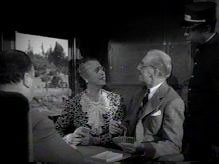
The Lodger
(1926)
Once at a desk in a news room and again in a crowd
watching an arrest.
Easy Virtue (1927)
Walking by a tennis court with a walking stick.
Blackmail (1929)
Being bothered by a boy while trying to read on
the subway.
Murder (1930)
Walking by the house where the murder was committed.
The Thirty-Nine Steps (1935)
Seen outside the Theatre at the beginning of the
film throwing away trash
Young and Innocent (1937)
Outside a courthouse with a camera.
The Lady Vanishes (1938)
Smoking a cigarette in Victoria Station.
Rebecca(1940)
Walking by a phone booth in which George Sanders
is making a call.
Foreign Correspondent(1940)
Outside a hotel reading the newspaper.
Mr. and Mrs. Smith (1941)
Passing Robert Montgomery outside his building.
Suspicion (1941)
Mailing a letter.
Saboteur (1942)
Waiting in front of a drug store.
Shadow of a Doubt (1943)
Playing cards on a train traveling to Santa Rosa
(shown on the right).
Lifeboat (1943)
Appearing in a newspaper advertisement (shown on
the right).
Spellbound(1945)
Smoking a cigarette and carrying a violin as he
exits an elevator.
Notorious (1946)
Drinking champagne in Claude Rains's mansion (shown
on the right).
The Paradine Case (1947)
Carrying a cello as he leaves a train.
Rope (1948)
Hitchcock's drawing of his profile can be seen from
the apartment window as a large neon light.
Under Capricorn (1949)
In a crowd during a parade.
Stage Fright (1950)
Looking at the disguised Jane Wymann.
Strangers on a Train (1951)
Boarding a train as Farley Granger exits; carrying
an upright bass.
I Confess (1952)
Crossig the top of a staircase.
Dial M for Murder(1953)
In a class reunion photo.
Rear Window(1954)
Instructing the songwriter and winding his clock
(shown at top).
To Catch a Thief (1955)
Sitting next to Cary Grant on a bus.
The Trouble with Harry (1956)
Passing a parked limousine.
The Man Who Knew Too Much (1956)
Watching performers in the Moroccan marketplace.
The Wrong Man (1957)
Narrating the film's prologue.
Vertigo (1958)
Walking down the street.
North by Northwest (1959)
Just barely missing a bus (shown on the right).
Psycho (1960)
Wearing a cowboy hat outside Janet Leigh's office.
The Birds(1963)
Exiting a petshop with two white terriers as Tippi
Hedren enters (shown on right).
Marnie (1964)
Walking through a hotel.
Torn Curtain(1966)
Waiting in a Hotel lobby with a baby.
Topaz(1969)
Being pushed in a wheel chair in the airport, stands
up, shakes hands with a man, and walks away.
Frenzy (1972)
In the center of a crowd.
Family Plot(1976)
Seen as a silhoutte through the window of the Registrar
of Births and Deaths.
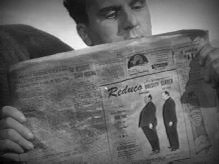
Lifeboat
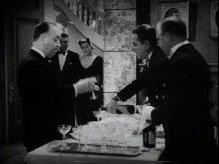
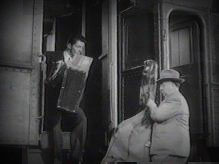
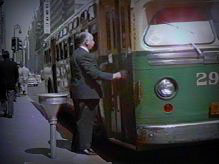
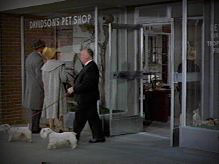
introduction | influences | cameos | symbolism | contemporary art | bibliography